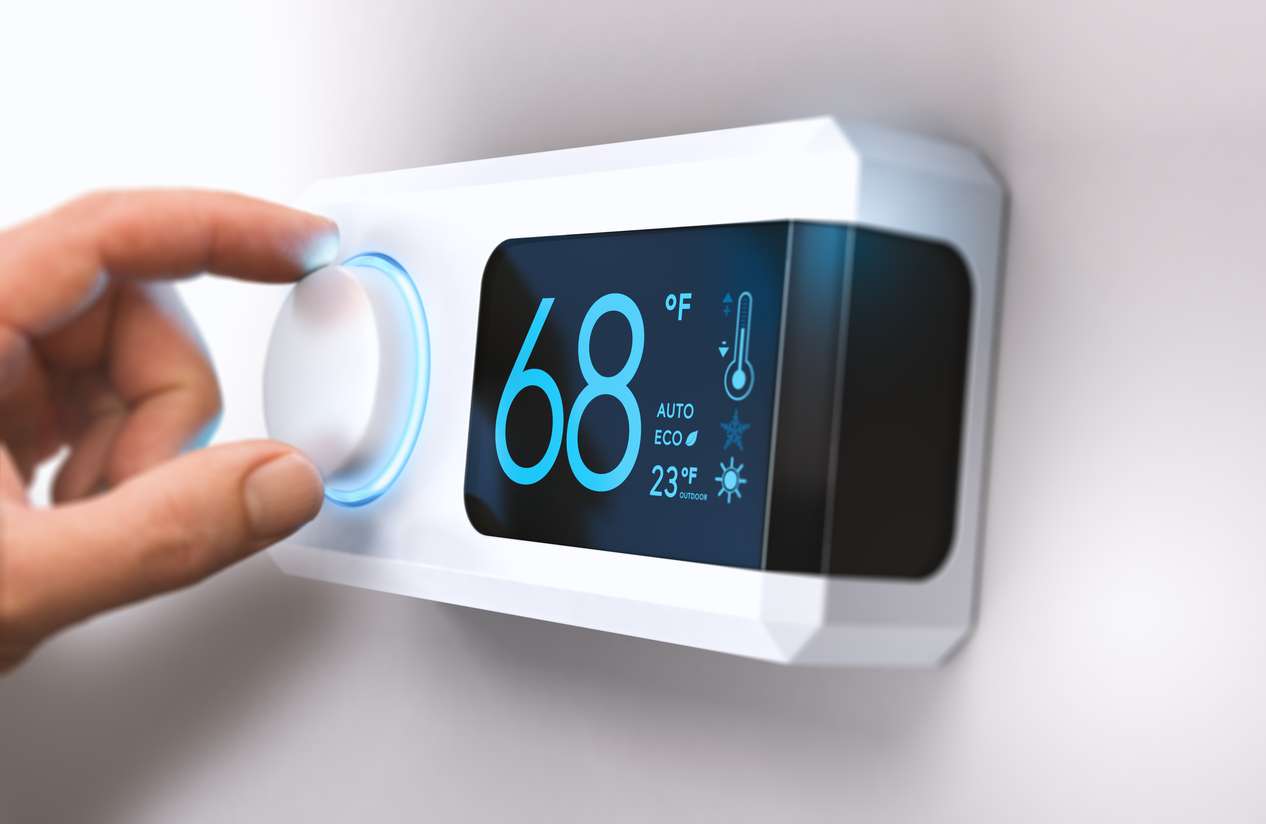A thermostat is a simple yet incredibly sophisticated device that has become an integral part of our modern lives. Its primary function is to regulate and control the temperature of a heating or cooling system in a building or a device. But beyond this basic function lies a world of importance and complexity that affects our comfort, energy efficiency, and overall quality of life. Do you have ever thought what are the functions of a thermostat? Well, it serves several important functions:
Temperature Control

Temperature control in the home is a vital aspect of creating a comfortable and livable environment. At the heart of effective temperature control systems lies the thermostat, a device designed to monitor and regulate indoor temperatures. Whether it’s the scorching heat of summer or the freezing cold of winter, the thermostat ensures that your home remains within your preferred temperature range, optimizing comfort and energy efficiency. A thermostat controls home temperature by monitoring the current temperature in a space and comparing it to a user-set desired temperature, known as the setpoint. It then activates or deactivates heating or cooling systems to maintain the temperature as close to the setpoint as possible. Here’s a step-by-step explanation of how the thermostat can have the functions to control temperature:
Temperature Sensing
Every thermostat contains temperature sensors that serve as its sensory organs. These sensors come in various types, including bimetallic coils, thermistors, or modern electronic sensors, each meticulously designed to accurately sense the surrounding temperature. This ability to sense temperature is the first step in a thermostat’s journey to maintain a comfortable environment.
Setpoint Adjustment
As users, we set our desired temperature on the thermostat. This preferred temperature is commonly referred to as the “setpoint.” It represents the temperature at which we want our living space to be maintained. The set point is the thermostat’s guiding star, the target it strives to reach and maintain.
Temperature Comparison
With the setpoint established, the thermostat constantly compares the current temperature, as sensed by its sensors, to this desired setpoint temperature. It calculates the difference between the two, determining whether they align or diverge.
Decision-Making
Based on this continuous comparison between the current temperature and the setpoint, the thermostat engages in a perpetual process of decision-making. It evaluates the situation and decides whether it should activate or deactivate the heating or cooling systems. These decisions are not arbitrary; they are guided by the thermostat’s internal logic.
Activating Heating or Cooling
When the current temperature falls below the setpoint and heating is required to achieve the desired comfort level, the thermostat springs into action, signaling the heating system to commence operation. This heating system could take various forms, from traditional furnaces to heat pumps, electric baseboard heaters, or other heating sources, depending on the specifics of your home’s HVAC (Heating, Ventilation, and Air Conditioning) system.
Conversely, if the current temperature rises above the setpoint and cooling is needed to create a comfortable indoor atmosphere, the thermostat switches gears, activating the cooling system. This may involve the use of an air conditioner, a heat pump operating in cooling mode, or other cooling equipment, all of which serve to lower the temperature and bring it in line with the setpoint.
Maintaining Temperature
Once the heating or cooling system is set in motion, it operates diligently until the thermostat determines that the current temperature is approaching the set point. At this juncture, the thermostat issues instructions to the heating or cooling system, advising it to slow down or cease its operations. This measured approach prevents overshooting the desired temperature, ensuring that your living space remains comfortably within the desired range.
Continuous Monitoring
The thermostat’s mission doesn’t conclude when the heating or cooling system is deactivated. Instead, it continues its vigilant monitoring of the temperature, making minor adjustments as necessary to keep the temperature within a tight range around the setpoint. This continuous vigilance is key to maintaining consistent comfort.
Energy Efficiency
While the primary objective of a thermostat is to provide comfort by maintaining a desirable temperature, it also shoulders the important responsibility of promoting energy efficiency. In our era of heightened environmental awareness and rising energy costs, this dual role is more critical than ever.
User Control and Programming
Many thermostats today offer user-friendly interfaces that empower homeowners to take control of their indoor climate. With these interfaces, you can set schedules, modify temperature settings, and program-specific temperature adjustments for various times of the day or week. This level of customization empowers homeowners to optimize temperature control according to their unique preferences and daily routines.
A thermostat controls home temperature by continuously monitoring the current temperature, comparing it to a user-set desired temperature (setpoint), and activating or deactivating heating or cooling systems accordingly. This process ensures that the indoor temperature remains comfortable and within the desired range while maximizing energy efficiency and convenience for homeowners.
Programming & Scheduling

Thermostats can be programmed and scheduled because of their design and technology. Programmable and scheduled thermostats offer a high level of convenience to homeowners. Instead of manually adjusting the thermostat multiple times a day, you can set your desired temperature profiles for different times and days of the week. This automation simplifies temperature control and reduces the need for constant adjustments. With scheduling thermostats, you are enable to optimize your heating and cooling systems for energy efficiency. By raising or lowering the temperature when no one is at home or when occupants are sleeping, energy consumption is reduced, leading to lower utility bills and reduced environmental impact.
The programmed thermostat also helps maintain a consistent indoor temperature. This consistency enhances comfort by avoiding sudden temperature fluctuations. Returning to a home with a pre-set comfortable temperature after being away contributes to a more pleasant living environment. Different people have different temperature preferences and daily routines. Programmable thermostats allow you to customize temperature schedules to suit your lifestyle, ensuring that the home is comfortable when needed and conserving energy when it’s not.
The ability of thermostats to be programmed and scheduled is made possible through technology and design features. With digital interfaces, many modern thermostats come with LCD screens or touchscreens, which allow you to easily program and schedule temperature settings. You can input specific temperature targets for different times of the day or week. It also has built-in clocks and timers. So, you can set the time when you want temperature changes to occur, such as during the night or when you are typically away from home.
You can input your desired temperature setpoints for different periods. For example, you can specify a lower temperature at night for sleeping comfort or a higher temperature during waking hours. Thermostats typically allow different schedules to be set for different days of the week. This feature accommodates variations in routines, such as weekends when people may be home during different hours. You can also typically set recurring schedules, which means the thermostat will repeat the programmed schedule daily or weekly. Most thermostats also offer the ability to manually override the programmed schedule temporarily, in case of unexpected changes in plans. You can also remotely control smart thermostats through smartphone apps or web interfaces, allowing for real-time adjustments.
Temperature Consistency

Thermostats are integral components in the realm of maintaining temperature control and comfort in controlled environments, be it the cozy confines of a home or the productive ambiance of an office. In an age where climate control has become second nature, thermostats play a pivotal role in ensuring that the temperature inside these spaces remains consistent, catering to our preferences and seasons alike. This article delves deeper into the significance of thermostats, their multifaceted functions, and their profound impact on our daily lives.
One cannot overstate the importance of comfort in our lives. It is the linchpin of our well-being and productivity, and thermostats are the gatekeepers to this comfort. These ingenious devices grant homeowners the ability to exercise precise control over the indoor temperature, thereby creating an environment that is welcoming and adaptable. Whether it’s the icy chill of winter or the sweltering heat of summer, thermostats stand as sentinels, ensuring that the climate inside remains tailored to our desires.
Imagine working in an office where the temperature seems to oscillate wildly, never quite settling at a comfortable level. Or perhaps, you’ve experienced the restlessness that comes from trying to sleep in a room where the temperature refuses to cooperate. Such scenarios are not just frustrating; they are productivity killers. Fluctuating temperatures can wreak havoc on our concentration, mood, and overall satisfaction with our living or working environment.
When the temperature is inconsistent, our bodies expend energy trying to regulate themselves. In the process, our focus wanes, our efficiency dwindles, and our overall well-being takes a hit. It’s clear that the comfort provided by thermostats extends far beyond just the physical; it nurtures our mental and emotional states as well.
While thermostats are undeniably guardians of our comfort, they are also champions of energy efficiency. The link between consistent temperature control and energy conservation is profound. When thermostats maintain temperatures within a narrow range around a desired setpoint, heating and cooling systems operate with greater efficiency. Consider this: when the temperature remains steady, HVAC (heating, ventilation, and air conditioning) systems don’t need to wage an energy-intensive battle to restore the environment to the desired comfort level after large temperature fluctuations. The result? Reduced energy consumption and lower utility bills.
But how do thermostats achieve this delicate balancing act between comfort and efficiency? At their core, thermostats are not mere switches that turn heating or cooling systems on and off at a whim. Instead, they operate as vigilant monitors of temperature, constantly assessing the ambient conditions and making minor adjustments to the heating or cooling systems as required to keep the temperature as close to the setpoint as possible.
To avoid rapid and disruptive cycling of HVAC systems, thermostats often incorporate a feature called hysteresis. This means that the thermostat doesn’t trigger the system immediately when the temperature veers slightly off the set point. Instead, it waits until the temperature deviates by a certain amount from the setpoint before taking action. This prudent delay prevents frequent and unnecessary system cycling, which not only leads to discomfort but also spikes energy consumption.
One size does not fit all when it comes to comfort. Recognizing this, many thermostats offer users the ability to fine-tune parameters like hysteresis and other temperature control settings to align with their specific preferences. This level of customization empowers individuals to maintain even tighter control over temperature consistency, ensuring that their indoor environment is a perfect match for their comfort needs.
The thermostat landscape has evolved significantly in recent years with the advent of smart thermostats. These technologically advanced devices take temperature control to a whole new level. Smart thermostats can be controlled remotely via smartphones, allowing users to adjust the temperature from virtually anywhere. They also often feature learning algorithms that adapt to your schedule and preferences, optimizing energy usage without sacrificing comfort.
One standout function of smart thermostats is they can connect to the Internet of Things (IoT). This means they can communicate with other smart devices in your home, creating a seamless, interconnected ecosystem that enhances both comfort and energy efficiency. For instance, a smart thermostat can communicate with smart lights to adjust lighting levels based on your presence and preferences, further reducing energy consumption.
Preventing Frozen Pipes

While thermostats are commonly associated with maintaining a comfortable indoor environment and enhancing energy efficiency, their significance transcends these realms. One of their lesser-known but equally vital functions is to prevent the nightmare of frozen pipes, especially during the bone-chilling winter months. Frozen pipes can spell disaster, causing costly damage that includes burst pipes and water leaks. In this article, we delve deeper into how thermostats become the unsung heroes of winter home maintenance, shielding us from the woes of frozen pipes.
When the mercury drops dramatically outdoors, particularly dipping below the freezing point, the specter of frozen pipes looms large. It’s during these frigid spells that thermostats come to the rescue by ensuring that the indoor temperature remains above freezing. Typically set to around 55 degrees Fahrenheit (13 degrees Celsius) or higher, thermostats act as the guardians of our plumbing infrastructure, preventing the insidious grip of frost from wreaking havoc within our pipes.
Understanding why this prevention is crucial requires a quick lesson in physics. When the water inside pipes freezes, it undergoes a remarkable transformation. It expands, exerting an extraordinary amount of pressure on the inner walls of the pipes. This relentless pressure can lead to a catastrophic rupture, and when the ice eventually thaws, water can gush out unchecked, causing extensive water damage in its wake.
The key to preventing frozen pipes lies in maintaining a consistent and appropriate indoor temperature, and this is where thermostats shine. Their unyielding vigilance ensures that the temperature within the confines of your home remains above the freezing threshold. The insidious nature of freezing pipes means that a slight dip in temperature can have devastating consequences, making thermostat-controlled precision all the more critical.
To better understand the practical significance of thermostats in preventing frozen pipes, let’s consider a typical winter scenario. As night falls, the outside world turns into an icy realm, with temperatures plummeting to dangerous lows. Unbeknownst to you, your trusty thermostat is hard at work. Thanks to its scheduling feature, it has anticipated this temperature drop and cranked up the heat a notch, ensuring that your home remains a cozy sanctuary even as winter rages outside.
As the night progresses, the temperature outside drops further, inching ever closer to the freezing point. Inside, however, your thermostat stands as a resolute guardian, maintaining a steady indoor temperature that keeps your pipes safe from harm. While you sleep soundly, your thermostat tirelessly monitors and adjusts, ensuring that the conditions for frozen pipes never materialize. In the morning, you wake up refreshed, blissfully unaware of the frozen tundra outside. You step into your bathroom, turn on the faucet, and water flows freely and warmly. This is the magic of thermostats at work, ensuring that you’re shielded from the chaos that frozen pipes can unleash.

In conclusion, the thermostat is not just a device; it is a guardian of comfort, a champion of energy efficiency, and a protector of our homes. Its functions extend far beyond the simple act of regulating temperature. It embodies the essence of modern living, offering us not only comfort but also the power to control and optimize our indoor environments.
As technology continues to advance, thermostats will evolve further, becoming even smarter and more energy-efficient. They will adapt seamlessly to our lifestyles, learn our preferences, and integrate seamlessly into our smart homes. Through it all, the thermostat will remain an unsung hero, silently working in the background to ensure that our living spaces are not just habitable but truly comfortable and energy-efficient. So, the next time you adjust your thermostat to the perfect temperature or program it to save energy while you’re away, remember that this unassuming device plays a pivotal role in making our lives better, one degree at a time. Ready to transform your home into a haven of comfort and efficiency? Click this link to make the smart choice with a cutting-edge smart thermostat. Say goodbye to temperature fluctuations, high energy bills, and thermostat hassles.

